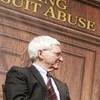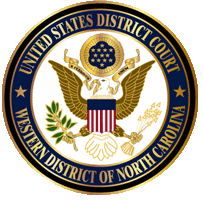A class action, also known as a class action lawsuit, class suit, or representative action, is a type of lawsuit where one of the parties is a group of people who are represented collectively by a member or members of that group. The class action originated in the United States and is still predominantly an American phenomenon, but Canada, as well as several European countries with civil law, have made changes in recent years to allow consumer organizations to bring claims on behalf of consumers.
In legal terminology, a complaint is any formal legal document that sets out the facts and legal reasons that the filing party or parties believes are sufficient to support a claim against the party or parties against whom the claim is brought that entitles the plaintiff(s) to a remedy. For example, the Federal Rules of Civil Procedure (FRCP) that govern civil litigation in United States courts provide that a civil action is commenced with the filing or service of a pleading called a complaint. Civil court rules in states that have incorporated the Federal Rules of Civil Procedure use the same term for the same pleading.
Frivolous litigation is the use of legal processes with apparent disregard for the merit of one's own arguments. It includes presenting an argument with reason to know that it would certainly fail, or acting without a basic level of diligence in researching the relevant law and facts. That an argument was lost does not imply the argument was frivolous; a party may present an argument with a low chance of success, so long as it proceeds from applicable law.
In law, a settlement is a resolution between disputing parties about a legal case, reached either before or after court action begins. A collective settlement is a settlement of multiple similar legal cases. The term also has other meanings in the context of law. Structured settlements provide for future periodic payments, instead of a one time cash payment.
The Private Securities Litigation Reform Act of 1995, Pub. L.Tooltip Public Law 104–67 (text)(PDF), 109 Stat. 737 ("PSLRA") implemented several substantive changes in the United States that have affected certain cases brought under the federal securities laws, including changes related to pleading, discovery, liability, class representation, and awards fees and expenses.

Frederick Martin "Fred" Baron was an American trial lawyer best known for representing plaintiffs claiming toxic and chemical exposure. He was also an active figure in politics as a fund-raiser for the Democratic Party.

Personal injury is a legal term for an injury to the body, mind, or emotions, as opposed to an injury to property. In common law jurisdictions the term is most commonly used to refer to a type of tort lawsuit in which the person bringing the suit has suffered harm to their body or mind. Personal injury lawsuits are filed against the person or entity that caused the harm through negligence, gross negligence, reckless conduct, or intentional misconduct, and in some cases on the basis of strict liability. Different jurisdictions describe the damages in different ways, but damages typically include the injured person's medical bills, pain and suffering, and diminished quality of life.

Lester Brickman is an emeritus professor at the Benjamin N. Cardozo School of Law of the Yeshiva University and a legal scholar. He is one of the founding faculty members of the Cardozo, recruited by Yeshiva University in 1976 from the University of Toledo College of Law. On May 31, 2016, Professor Brickman received the Monrad Paulsen Award of the Cardozo School, upon his retirement from teaching. He taught contracts, legal ethics and Land Use and Zoning at the Cardozo School of Law. He is the author of a book, Lawyer Barons: What Their Contingency Fees Really Cost America, a detailed critique of perceived abuses and excessive costs of the American tort system, with proposals for reform. Brickman is a graduate of Carnegie Mellon University. He holds a juris doctor degree from the University of Florida and an LLM degree from Yale Law School.

Tort reform consists of changes in the civil justice system in common law countries that aim to reduce the ability of plaintiffs to bring tort litigation or to reduce damages they can receive. Such changes are generally justified under the grounds that litigation is an inefficient means to compensate plaintiffs; that tort law permits frivolous or otherwise undesirable litigation to crowd the court system; or that the fear of litigation can serve to curtail innovation, raise the cost of consumer goods or insurance premiums for suppliers of services, and increase legal costs for businesses. Tort reform has primarily been prominent in common law jurisdictions, where criticism of judge-made rules regarding tort actions manifests in calls for statutory reform by the legislature.
Denise Louise Cote is a senior United States district judge of the United States District Court for the Southern District of New York.

In re Garlock Sealing Technologies, LLC is a court case heard in the United States District Court for the Western District of North Carolina which involves the entry into bankruptcy proceedings by Garlock Sealing Technologies, once a manufacturer of coated asbestos gaskets, as a result of potential liability from current and future settlements. The plaintiffs were over 4,000 asbestos victims suffering from mesothelioma, including many Navy veterans, as well as an unknown number of future mesothelioma victims. As noted by the court, mesothelioma "is always fatal, causing death essentially by suffocation within about eighteen months of diagnosis" and involves "a horrific death."
Weitz & Luxenberg P.C. is a large personal injury and medical malpractice law firm headquartered in New York, specializing in asbestos litigation. The firm also specializes in medical malpractice, consumer protection, and environmental protection litigation.
Levy Konigsberg is an American-based law firm that was established in 1985. The company is known for a number of high-profile cases in the United States. Its practice areas include asbestos litigation, qui tam, lead poisoning, sexual abuse, tobacco litigation, medical malpractice, and negligence. In 2015, Levy Konigsberg was recognized as one of the 50 Law Firms in the 2015 Elite Trial Lawyers list by The National Law Journal.
Perry Weitz is an American attorney and partner at the Manhattan law firm Weitz & Luxenberg, which he co-founded in 1986. He is also a founding partner of Oak Row Equities, a Miami Florida based real estate development company.
Simon Greenstone Panatier is a law firm based in Dallas, Texas, specializing in personal injury litigation and tort liability.
Within the United States, the use of asbestos is limited by state and federal regulations and legislation. Improper use of asbestos and injury from exposure is addressed through administrative action, litigation, and criminal prosecution. Injury claims arising from asbestos exposure may be tried as mass torts.
Baron & Budd, P.C. is an American plaintiffs' law firm headquartered in Dallas, Texas. Opponents of mass tort litigation have criticized the firm for the zealousness with which it represents its clients, and for the political activities of some of its attorneys.
Asbestos bankruptcy trusts are trusts established by firms that have filed for reorganization under Chapter 11 of the United States Bankruptcy Code to pay personal injury claims caused by exposure to asbestos. At least 56 such trusts were established from the mid-1970s to 2011.
Kananian v. Lorillard was an important case in asbestos litigation.
A Texas two-step bankruptcy is a two-step bankruptcy strategy under US bankruptcy law in which a solvent parent company spins off liabilities into a new company, and then has that new company declare bankruptcy. In the first step, the parent company undergoes a Texas divisive merger, which allows companies to split off their liabilities from their assets. In the second step, the newly created spin-off declares a chapter 11 bankruptcy, usually in North Carolina, where bankruptcy courts are perceived to be more open to this scheme. The Texas two-step allows solvent companies to shield their assets from litigants using protections that are normally reserved for bankrupt companies. The goal of a Texas two-step is for the parent company to gain a third-party release of all liabilities it assigned to its spinoff, thus preventing litigants from pursuing those claims against the parent.






